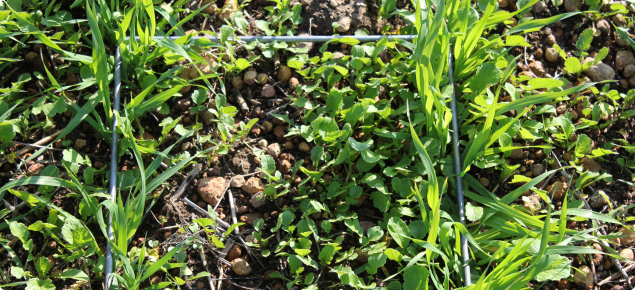Sampling and estimating weed density
How big should the quadrant be?
The size of the quadrant will depend on the weed density. Small quadrants (0.1m2) are adequate for weed populations greater than 200 plants per square metre. This would equate to counts above 20 plants per quadrant. For lower weed densities increase the quadrant size (up to 1m2) enabling counts between five and 50 plants per quadrant.
If the weed is in distinct patches across the paddock:
- Carry out plant counts within the patches only.
- Do at least five counts within each of at least four patches, giving 20 counts for the paddock. The more counts carried out, the more accurate the assessment.
If weeds are relatively uniformly distributed across the paddock:
Carry out a transect
Walk in a line across the paddock taking a set number of steps, then do a plant count (for example, walk in a ‘W’ path and make an assessment at regular intervals). The most important thing is to do at least 20 counts ensuring you have covered most of the paddock. Do not concentrate counts in one corner of the paddock.
Record the plant count for each weed species found.
Plant counting is an opportune time to record different aspects of the weeds and the crop. Consider whether plants appear small and stunted, or affected by insects or disease. Make observations on distribution, such as whether they are all growing in the furrow with no weeds in the inter-row, or if the density is higher in the header trails.
Also take note of other weeds present. Records should be able to be interrogated; showing changes in weed density and spectrum over time. These records can be an early warning of an emerging problem.
Estimating potential weed population density
Potential weed population density can be estimated in a number of ways.
- When weeds are setting seed, count the number of seed heads or pods and the number of seeds per pod or seed head, from a given sample area. This will give an estimate of the total number of seeds produced.
- A more complex but accurate method is to take soil cores, sieve and wash them and count the seeds in those samples. This technique is often limited to use as a research tool as it is time consuming and dependent on seed identification skills.
- Water small areas in the paddock and identify and count the germinating weeds. This can be done during autumn but does not always provide a realistic guide to the potential weediness due to the complex nature of seed dormancy.
Use paddock records from past monitoring to give an estimate of aspects such as weed species, density, seed-set and location. It allows you to monitor changes through time.

